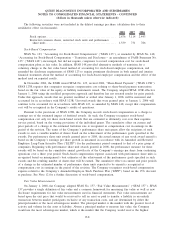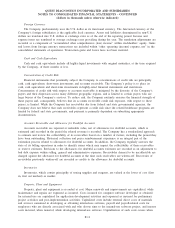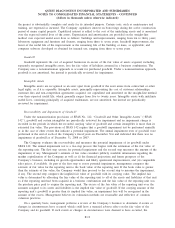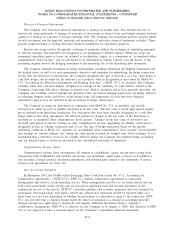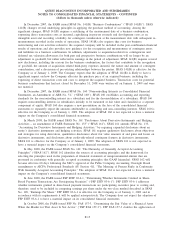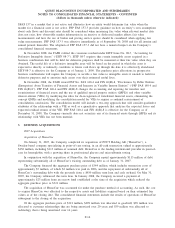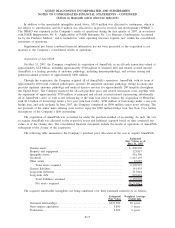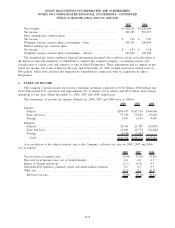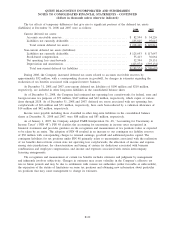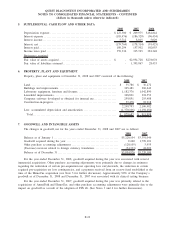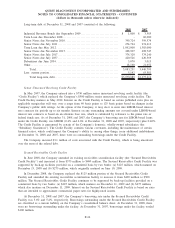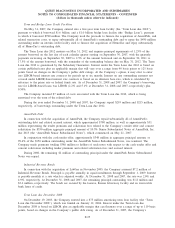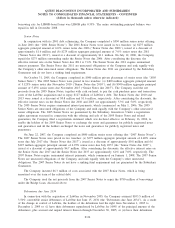Quest Diagnostics 2008 Annual Report Download - page 88
Download and view the complete annual report
Please find page 88 of the 2008 Quest Diagnostics annual report below. You can navigate through the pages in the report by either clicking on the pages listed below, or by using the keyword search tool below to find specific information within the annual report.SFAS 157 in a market that is not active and illustrates how an entity would determine fair value when the
market for a financial asset is not active. FSP FAS 157-3 provides guidance on how an entity’s own assumptions
about cash flows and discount rates should be considered when measuring fair value when relevant market data
does not exist, how observable market information in an inactive or dislocated market affects fair value
measurements and how the use of broker and pricing service quotes should be considered when applying fair
value measurements. FSP FAS 157-3 was effective immediately as of September 30, 2008 and for all interim and
annual periods thereafter. The adoption of FSP FAS 157-3 did not have a material impact on the Company’s
consolidated financial statements.
In November 2008, the FASB ratified the consensus reached under EITF Issue No. 08-7, “Accounting for
Defensive Intangible Assets” (“EITF 08-7”). EITF 08-7 requires that certain intangible assets acquired in a
business combination that will be held for defensive purposes shall be measured at their fair value when they are
obtained. The useful life of a defensive intangible asset will be based on the period in which the asset is
expected to directly or indirectly contribute to future cash flows up through the date it is effectively abandoned.
EITF 08-7 is effective for the Company as of January 1, 2009. The purchase price allocations in prospective
business combinations will require the Company to ascribe a fair value to intangible assets it intends to hold for
defensive purposes and to amortize such assets over their estimated useful lives.
In December 2008, the FASB issued FSP No. FAS 140-4 and FIN 46(R)-8, “Disclosures by Public Entities
(Enterprises) about Transfers of Financial Assets and Interests in Variable Interest Entities” (“FSP FAS 140-4 and
FIN 46(R)-8”). FSP FAS 140-4 and FIN 46(R)-8 changes the accounting and reporting for transfers and
securitizations of financial assets and the use of qualified special purpose entities (QSPEs) and other variable
interest entities (VIEs) by modifying the rules for de-recognition of transferred financial assets, eliminating the
concept QSPEs and modifying the consolidation model for VIEs to require a continual reassessment of
consolidation conclusions. The consolidation model will include a two-step approach that will consider qualitative
attributes of the relationship with a VIE as well as a quantitative approach that analyzes the expected losses and
expected residual returns of the VIE. FSP FAS 140-4 and FIN 46(R)-8 is effective for the Company as of
December 31, 2008. The Company currently does not securitize any of its financial assets through QSPEs and its
relationship with VIEs has not been material.
3. BUSINESS ACQUISITIONS
2007 Acquisitions
Acquisition of HemoCue
On January 31, 2007, the Company completed its acquisition of POCT Holding AB (“HemoCue”), a
Sweden-based company specializing in point-of-care testing, in an all-cash transaction valued at approximately
$450 million, including $113 million of assumed debt. HemoCue is the leading international provider in point-of-
care for hemoglobin, with a growing share in professional glucose and microalbumin testing.
In conjunction with the acquisition of HemoCue, the Company repaid approximately $113 million of debt,
representing substantially all of HemoCue’s existing outstanding debt as of January 31, 2007.
The Company financed the aggregate purchase price of $344 million, which includes transaction costs of
approximately $7 million, of which $2 million was paid in 2006, and the repayment of substantially all of
HemoCue’s outstanding debt with the proceeds from a $450 million term loan and cash on-hand. On May 31,
2007, the Company refinanced this term loan. In January 2008, the Company received a payment of
approximately $23 million from an escrow fund established at the time of the acquisition which reduced the
aggregate purchase price to $321 million.
The acquisition of HemoCue was accounted for under the purchase method of accounting. As such, the cost
to acquire HemoCue was allocated to the respective assets and liabilities acquired based on their estimated fair
values as of the closing date. The consolidated financial statements include the results of operations of HemoCue
subsequent to the closing of the acquisition.
Of the aggregate purchase price of $321 million, $298 million was allocated to goodwill, $38 million was
allocated to customer relationships that are being amortized over 20 years and $39 million was allocated to
technology that is being amortized over 14 years.
F-16
QUEST DIAGNOSTICS INCORPORATED AND SUBSIDIARIES
NOTES TO CONSOLIDATED FINANCIAL STATEMENTS - CONTINUED
(dollars in thousands unless otherwise indicated)




